- Home
- Orson Scott Card
Ender's World Page 3
Ender's World Read online
Page 3
Of course, the failure of such tests would not preclude their continued use; we have decades of experience with IQ and achievement tests, and many branches of pseudo-science or schools of thought within science, that prove people are able to hold on to provably absurd beliefs for an astonishingly long time, shaping public policy accordingly, and then refusing to admit the obvious consequences.
However, I was not writing a novel about how testing rarely shows what the testers believe that it shows. I posited instead that testing had actually become a science, and that the tests of these young children worked, at least well enough to bring some very, very talented children together in Battle School, with generally positive, useful results.
What would these fictional tests measure? They would have to include persistence at a task, aggressiveness, focus, anticipation of multiple consequences, envisioning of multiple alternative actions, formation of social bonds, perceptiveness about other people’s motives, and successful prediction of other people’s behavior. They would also test for verbal ability, logic, memory, and other standard IQ-test traits.
The use of monitors in addition to these tests is a tacit admission that even the best tests don’t measure everything. Observation would be needed as well, and even then, the quality of the results of that observation would depend on the abilities of the people doing the observing.
—OSC
THE MONSTER’S HEART
JOHN BROWN
The moment we turn works of literature into puzzles, into clever and tricky essays that readers are supposed to sleuth through in order to find clues that reveal the true meaning—in that moment, the work dies. Oh sure, there are things to learn. But they are the things you learn from a cadaver, not the things you experience with a living soul.
For too long the discussion of literature has focused on meaning: on concepts, puzzles, symbols, themes, and ideas. On “what do you make of that?” I refuse to do that here with Ender’s Game. I refuse to kill that story and everyone in it.
Why?
Because I prize the people I’ve met, the insights I’ve gleaned, the places I’ve been. I prize the experience. That’s why I go to literature.
I don’t watch Fiddler on the Roof about once every other year because of what it means. I don’t watch the 1995 BBC production of Pride and Prejudice (the one starring Colin Firth) with my daughters with the same regularity because it’s an exploration of views on women and class in the landed gentry of early-nineteenth-century England. I rewatch these stories because the people and situations in them delight me: they make me laugh, cry, and think. They change my heart.
I believe most readers go to fiction for the same reason. It’s the experience we’re after—the laughter, the delight, the poignancy, the loss, the longing, the triumph, the suspense, the insight. And so that’s what I’m going to share with you here. I’ll start by summarizing the process of literary experience and then discuss three parts of my joyful and poignant experience with Ender.
Snakes
A few years ago, my wife, four daughters, and I lived in a nine-hundred-square-foot home that my wife’s grandmother had homesteaded up in the Rocky Mountains of northern Utah. It is made of rough-hewn logs that have been covered up with fading green aluminum siding on the outside and modern-day drywall inside. It has sloping floors, which means the oven slopes, resulting in cakes that are thick on one end and thin on the other. It also has one bathroom right off the kitchen with a trick door that will, now and again, open of its own accord, so that anyone sitting on the toilet can say hello to the visitors at the kitchen table (such a thoughtful door).
Because the house is in the mountains at the rural edge of the wilderness and a mile from the nearest neighbor, we had many wild visitors. Many in this area do. Moose, elk, eagles, badgers, rattlers, tourists wearing alarming summer wear—you name it; it’s bound to show up in your yard eventually. For example, one of our neighbors was about to open her back door one day and saw a skunk hightailing it out of her yard. She wondered what was scaring it, then looked down at her dog’s food bowl and saw two cougar kittens enjoying Fido’s food, which is very cute until mamma cougar spots big-human-dinner and decides to drag it away by the neck.
At that time, my office was in a souped-up cow shed behind the house. One summer day, I came out of my shed, walked around the side of the house, and stepped on something slithering through the grass. Alarm immediately raced through me. I jerked back; my heart began to palpitate; I focused on the snake. It was long. Real long! It stretched at least twenty feet through the shaggy lawn. Then my reality meter went bong—a twenty-foot snake?!? I looked closer. It wasn’t a snake—it was the garden hose! I laughed, my heart began to slow, and the adrenaline washed out of me. I continued on, probably to visit with said bathroom.
There are three parts to emotional experience as illustrated by that snake in the grass.
(1) Some sensory stimuli triggers a super-fast, rough, pre-cognitive appraisal that something in our environment is likely to affect our wants, interests, goals, values, etc., or those of someone we care about. In my case, my brain appraised that I’d stepped on a “bad slither.” Fangs in your leg is kind of a big deal, especially when they may inject large quantities of hemotoxic venom (yes, the kind that is real nifty for inducing heart failure).
(2) This pre-cognitive appraisal triggers physiological changes that help us focus attention on the situation, prepare us to respond, and communicate the situation to others. A lot of this physiological response is what we describe as emotion. For example, the feeling of romantic love is produced by a delightful cocktail of chemicals rushing to various parts of our bodies. The same goes for fear, rage, mirth, etc.
This physical response also affects subsequent appraisals. This occurs, in part, because of the focus I mentioned before, which is sometimes called the orienting reflex. When you see someone who may become the love of your life or someone intent on murdering you, it’s helpful if you don’t get distracted. The orienting reflex helps you keep your eye on both murderers and potential mates alike. However, if we’re focusing on some things, that means we can’t focus on or sometimes even see others. It also means new stimuli are fitted into the framework created by our initial appraisal.
For example, when you’re alone in a dark house and already spooked, your physical response fixes your attention on threats. And so you will appraise the sound of something falling downstairs differently than when you’re full of mirth or thinking about the fact that Johnny has been downstairs for a while and has been unusually quiet.
The effect of selective attention can be a great help—it filters out things that would otherwise be a distraction, at times when we can’t afford to be distracted—but also can sometimes lead to damaging distortions. One of the central aspects of cognitive behavioral therapy when treating depression or phobia is to help the subject break out of the confines of their selective attention and see the details that lead them to appraise their situation in a more accurate manner.
With the snake, my brain focused, and ordered up some adrenaline and an increased heart rate to help me run; it also ordered up a flinch, and wrote alarm all over my face, which would draw the attention of others, who might help or flee.
(3) After the pre-cognitive appraisal and initial physiological response, which happens in less than the blink of an eye, we cognitively appraise the situation. This is the conscious thought part. In my case, I looked closer and thought, “It’s a garden hose, you dope!” This new appraisal totally changed the nature of the situation. It triggered a different physiological response, including a new mix of emotion.
So we have these parts that feed into the process of emotion: cues in the environment, pre-cognitive appraisals of the situation, cognitive appraisals, and physiological responses. But what do these parts have to do with Ender’s Game? Everything. Because we react in this way to more than sensory stimuli—we also react this way to our thoughts, including thoughts evoked by words on th
e page.
How is this possible?
It’s possible because our pre-cognitive appraisals do not distinguish between real and imagined scenarios.1 The precognitive system takes whatever input is given—sensory or imagined—and appraises it. And that appraisal triggers the physical response.
This is why we can weep or laugh upon recalling some past event. We’re not just remembering the event, we’re reliving it, reappraising it. This is also why listening to a friend tell us a story about a terrible accident can make us cringe. Or listening to that same friend tell us about his toddler eating dog poo can make us cringe even harder. Even though we weren’t present when the actual events occurred, we still witness the events in our minds, and our pre-cognitive system appraises them. This lack of distinction between sensory and imagined stimuli is why people with phobic fear of snakes not only fear real, live snakes but also have powerful reactions when simply imagining or reading about them.
You might think that our cognitive (conscious) appraisal system would come to the rescue with some reason. After all, didn’t it point out that my snake was a garden hose? Won’t it point out that our thoughts aren’t real and, with regard to fiction, that the people and places we’re reading about are all made up?
It can if something in the story is so unbelievable that our reality meters start to sound like mine did when I noticed the snake’s length. But when the author presents plausible situations, our reality meters don’t make a peep. They don’t constantly remind us it’s made up because our conscious thought is limited to the capacity of our working memory, and that capacity is small. Studies have shown that our working memory has room to hold only five to nine chunks of information at the same time. What constitutes a chunk can vary, but if you want to test this (as my fourteen-year-old did), have someone read you a list of ten to fourteen random names or numbers, then try to repeat those names or numbers back. You just can’t hold more than five to nine things in your working memory at one time. But it gets worse. When we want to do anything with those chunks besides recall them (like manipulate them in a math problem or identify correlations between them), our capacity drops to two to four chunks.
Bottom line: our pipes for conscious thought aren’t very fat. And so when what we’re imagining completely maxes out that bandwidth, there is no room to think about the fact that it’s just our imagination or just a work of fiction. We simply react to the imagined stimuli as if they were real and in front of us.
For fiction to provide an experience then, all it needs to do is present the situational cues to us that will automatically trigger our appraisals and physiological responses. This doesn’t mean fiction must show us the situation. In fact, despite the often-repeated eleventh writing commandment, “Show, don’t tell,” the truth of the matter is that a text never shows a reader anything except marks on a page—it never presents the raw situational data through our senses. Movies and plays can show. They can also provide raw auditory input. But a book never shows us anything. It’s all tell, tell, tell. The trick is to tell in a way that allows the reader to imagine the situation with enough clarity and realism that the imagined situation triggers the response. Of course, the situation itself (characters, motives, events, setting, etc.) needs to be ripe with potential in the first place, but developing that situation and helping the reader imagine it are two different things.
An author can guide a reader through a great variety of experiences—sympathy, suspense, poignancy, wonder, awe, mirth, dread, romantic love, etc. Orson Scott Card, in Ender’s Game, guides us through a number of them. What I want to do now is explore part of that experience by doing what we all do when we quote lines from our favorite movies or books to each other: enjoy the experience all over again and, in the process, perhaps deepen it.
Transporting the Reader to Ender’s World
When we read a book and feel as if we’ve been transported to another place, we often assume it’s because the author has provided lots of setting detail. However, Card demonstrates that’s not necessary. And, consequently, that what a writer is really doing is not “showing” but telling in a way that invites a reader to bring his or her own imagination to bear.
Let’s look at the opening of Ender’s Game as an example. We start off with two disembodied voices with zero setting nouns. As a result, I didn’t see (imagine) any setting during that portion. But then we move into the scene where Ender’s monitor is removed. That scene is 767 words long. How much of that is setting?
I’m sure you imagined it very clearly. I did. I saw (imagined) Ender in a doctor’s office and a kind of operating room. It wasn’t super-detailed, but I saw the examination table with white paper on it. I saw a male doctor, nurse, and another woman in white uniforms. I saw vague chrome shapes representing medical equipment surrounding them. I saw a syringe. I saw bright light from overhead and more subdued lighting in the corners. I even felt a little cold.
But the text never mentions uniforms or white. It never mentions paper on the table or chrome. It never describes the syringe or the lighting. In fact, it says almost nothing. Card provides a whopping six setting nouns for his description: monitor lady, horrible monitor, examining table, doctor, nurse, needle.
Six.
And if you take away the characters, it’s really only three.
What the…? How can he create a setting with just three general details?
It’s possible because this is text and Card isn’t creating a setting. He’s helping us imagine one. He doesn’t need to tell us about everything in detail for us to build the image in our minds. That wouldn’t work anyway because of our working memory limitations. All he has to do is provide a few key words, and we pull up into working memory other constructs that we associate with those words.
This isn’t a one-for-one relationship: Card’s six descriptive terms won’t prompt each reader to imagine exactly the same thing. For example, if you’ve never been in an operating room, there’s no reason for you to have felt cold. And so I suspect what some of you imagined didn’t include that. But I’ve been in plenty, and so that came with it. Of course, Card never said operating room, did he? He said examination table, which means this could be a warm room in a doctor’s office. For whatever reason, I saw this as a more official procedure. You may have seen something slightly different.
But it really wouldn’t have mattered, would it? Because the key thing Card is doing here is not transporting us to an exact place. It’s transporting us to a character and a threat to his well-being. Who cares if you saw a small doctor’s office and I saw an operating room? We both saw Ender almost become a vegetable. We both heard his interesting internal response to the statement that the removal wouldn’t hurt a bit. We both learned that Ender’s brother hated him, and that Ender just wanted not to be hated.
I’m not saying this is the optimal amount of setting stories should have. I’m simply saying that it doesn’t take much to prompt a reader’s mind to imagine a world. Furthermore, by limiting the time spent on setting, Card is able to spend more time helping the reader imagine the characters—their thoughts, motives, actions, and speech—and on the threats other characters pose to those we’re rooting for. In movie terms, the vast majority of the scenes I imagined were simple medium and close-up shots, uncluttered by atmosphere. By nature, such shots are designed to focus on the characters. This focus is one of the hallmarks of Card’s style—transporting us not so much to the place as the mind and heart.
Card’s decision to focus on character over setting isn’t simply a stylistic choice du jour. If you think about novels as the result of authors finding and inventing cool things to share with readers, then it’s clear that Card delights in sharing the inner workings of his characters. He delights in sharing motives and reactions that are not always what’s expected at first blush. Or as simple.
Stage time is precious, and Card spends a huge portion of his telling us why Ender does what he does. He also transports us to the motives of others. The d
isembodied voices at the beginning of each chapter discuss their motives. Valentine constantly guesses at Peter’s motives. Ender constantly appraises why the people around him do what they do. His special insight is one of his larger-than-life gifts. For example, it’s not enough to know that Bonzo Madrid feels compelled to attack Ender because Ender undercut him. Ender digs deeper, appraising how his culture and role as commander of the Salamander Army plays into the situation.
But it’s not just the characters that are appraising the situations they face. Card is guiding us in our appraisals of those same situations. Sometimes our appraisal matches the character’s. Sometimes we have privileged information that leads to a different view. And sometimes it’s the character who has surprising special insight that alters our perceptions. Card likes to dig below the surface, and this allows him to guide us into a series of appraisals that sometimes change our response as dramatically as my response was changed when I realized what I’d stepped on was a hose, not a snake.
The Hive Queen: From Revulsion to Love
The crowning scene of Ender’s Game, its last gift, is all about going beyond the surface to know why someone does a thing and how knowing the why can completely change our appraisal of that person. Ender becomes the Speaker for the Dead, but it’s in the scene with the hive queen that the reader experiences what such a speaking means.
Through most of the story, our knowledge of the formics is limited. We know that they look like bugs, don’t communicate with us, and slaughter us without provocation or remorse. It’s us or this plague of horrible insects. But at the end, after Ender has destroyed the formics and gone to live on another planet, he finds the playground the formic queen built for him. He finds the egg. And we are guided into an experience that alters our view of the formics forever. In this scene, Card presents to us a snake, and then transforms it into something entirely different.

 Shadows in Flight
Shadows in Flight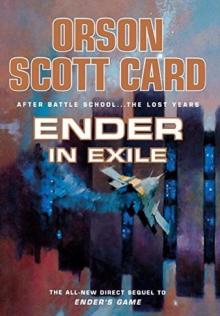 Ender in Exile
Ender in Exile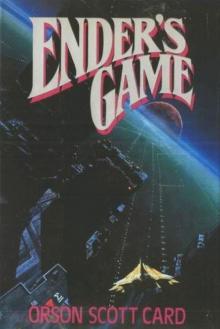 Ender's Game
Ender's Game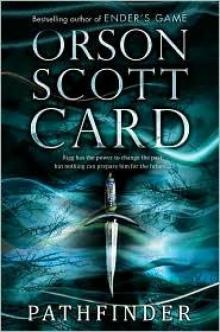 Pathfinder
Pathfinder Children of the Fleet
Children of the Fleet Children of the Mind
Children of the Mind Ruins
Ruins Speaker for the Dead
Speaker for the Dead Ender's Shadow
Ender's Shadow Folk of the Fringe
Folk of the Fringe Hart's Hope
Hart's Hope Shadow of the Giant
Shadow of the Giant Empire
Empire Shadow Puppets
Shadow Puppets Earth Afire
Earth Afire First Meetings in Ender's Universe
First Meetings in Ender's Universe Maps in a Mirror: The Short Fiction of Orson Scott Card
Maps in a Mirror: The Short Fiction of Orson Scott Card Xenocide
Xenocide The Swarm: The Second Formic War
The Swarm: The Second Formic War Saints
Saints Seventh Son: The Tales of Alvin Maker, Volume I
Seventh Son: The Tales of Alvin Maker, Volume I Zanna's Gift
Zanna's Gift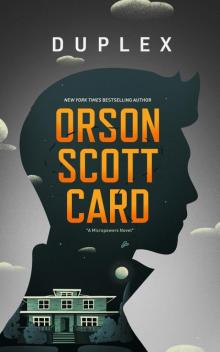 Duplex
Duplex Zanna's Gift- a Life in Christmases
Zanna's Gift- a Life in Christmases Hidden Empire
Hidden Empire Earth Awakens
Earth Awakens Visitors
Visitors Shadow of the Hegemon
Shadow of the Hegemon Alvin Jorneyman ttoam-4
Alvin Jorneyman ttoam-4 Federations
Federations The Gate Thief mm-2
The Gate Thief mm-2 First Meetings
First Meetings Capitol
Capitol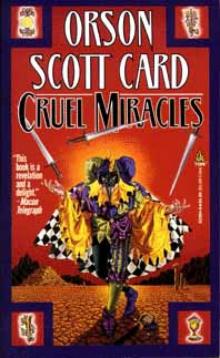 Cruel Miracles
Cruel Miracles Shadows in Flight, enhanced edition
Shadows in Flight, enhanced edition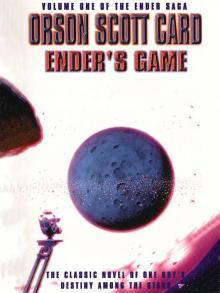 Ender's Game es-1
Ender's Game es-1 Ruins (Pathfinder Trilogy)
Ruins (Pathfinder Trilogy) Ender's Shadow ew-6
Ender's Shadow ew-6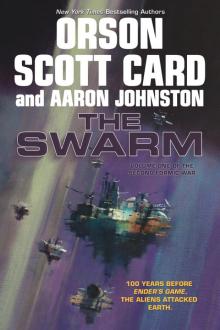 The Swarm
The Swarm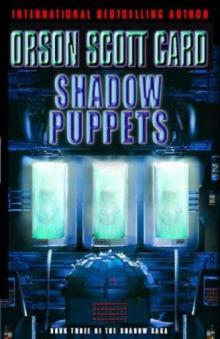 Card, Orson Scott - Ender's Saga 7 - Shadow Puppets
Card, Orson Scott - Ender's Saga 7 - Shadow Puppets Lost Boys: A Novel
Lost Boys: A Novel Mazer in Prison
Mazer in Prison Treason
Treason Heal Thyself
Heal Thyself The Call of Earth
The Call of Earth Songmaster
Songmaster Heartfire ttoam-5
Heartfire ttoam-5 Pastwatch
Pastwatch Gatefather
Gatefather The Ships of Earth: Homecoming: Volume 3
The Ships of Earth: Homecoming: Volume 3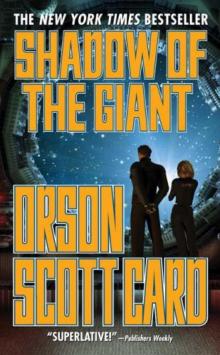 Orson Scott Card - Ender 08 - Shadow of the Giant
Orson Scott Card - Ender 08 - Shadow of the Giant Flux
Flux Speaker for the dead ew-2
Speaker for the dead ew-2 Grinning Man
Grinning Man Ruins sw-2
Ruins sw-2 Earth Unaware
Earth Unaware The Worthing Saga
The Worthing Saga Earthfall (Homecoming)
Earthfall (Homecoming) Card, Orson Scott - Ender's Saga 5 - Ender's Shadow
Card, Orson Scott - Ender's Saga 5 - Ender's Shadow The Abyss
The Abyss Magic Street
Magic Street Masterpieces
Masterpieces Prentice Alvin ttoam-3
Prentice Alvin ttoam-3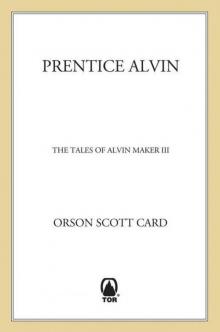 Prentice Alvin: The Tales of Alvin Maker, Volume III
Prentice Alvin: The Tales of Alvin Maker, Volume III Card, Orson Scott - Ender's Saga 3 - Xenocide
Card, Orson Scott - Ender's Saga 3 - Xenocide Homeless in Hell
Homeless in Hell Red Prophet: The Tales of Alvin Maker, Volume II
Red Prophet: The Tales of Alvin Maker, Volume II Earthborn (Homecoming)
Earthborn (Homecoming)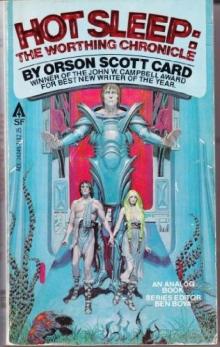 Hot Sleep
Hot Sleep The Hive
The Hive Rachel and Leah (Women of Genesis)
Rachel and Leah (Women of Genesis) Ender's World
Ender's World The Memory of Earth
The Memory of Earth Seventh Son ttoam-1
Seventh Son ttoam-1 Wyrms
Wyrms A Town Divided by Christmas
A Town Divided by Christmas Earth unavare (the first formic war)
Earth unavare (the first formic war) The Shadow of the Hegemon - Orson Scott Card
The Shadow of the Hegemon - Orson Scott Card Earthfall
Earthfall Lost Boys
Lost Boys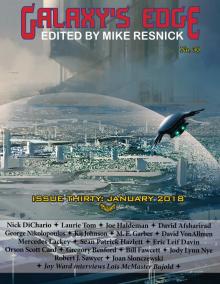 Galaxy's Edge Magazine
Galaxy's Edge Magazine Sarah: Women of Genesis: 1 (Women of Genesis (Forge))
Sarah: Women of Genesis: 1 (Women of Genesis (Forge)) The Crystal City: The Tales of Alvin Maker, Volume VI
The Crystal City: The Tales of Alvin Maker, Volume VI Xenocide ew-4
Xenocide ew-4 Earth Afire (The First Formic War)
Earth Afire (The First Formic War) Maps in a Mirror
Maps in a Mirror Pathfinder sw-1
Pathfinder sw-1 Red Prophet ttoam-2
Red Prophet ttoam-2 THE CRYSTAL CITY
THE CRYSTAL CITY 27 Short Stories
27 Short Stories Heartfire: The Tales of Alvin Maker, Volume V
Heartfire: The Tales of Alvin Maker, Volume V Alvin Journeyman: The Tales of Alvin Maker, Volume IV
Alvin Journeyman: The Tales of Alvin Maker, Volume IV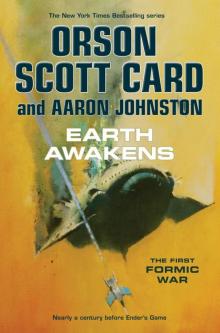 Earth Awakens (The First Formic War)
Earth Awakens (The First Formic War) THE SHIPS OF EARTH
THE SHIPS OF EARTH The Changed Man
The Changed Man Future on Fire
Future on Fire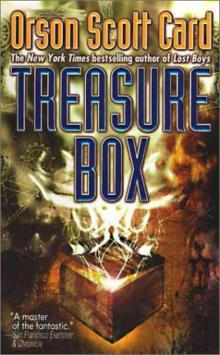 Treasure Box
Treasure Box The Gate Thief
The Gate Thief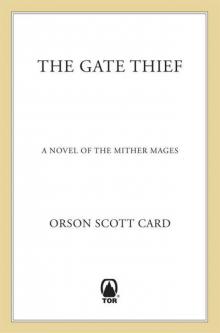 The Gate Thief (Mither Mages)
The Gate Thief (Mither Mages) First Meetings In the Enderverse
First Meetings In the Enderverse Earthborn
Earthborn Seventh Son
Seventh Son Pastwatch: The Redemption Of Christopher Columbus
Pastwatch: The Redemption Of Christopher Columbus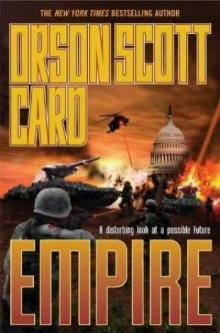 Empire e-1
Empire e-1 Keeper of Dreams
Keeper of Dreams Card, Orson Scott - Ender's Saga 1 - Ender's Game
Card, Orson Scott - Ender's Saga 1 - Ender's Game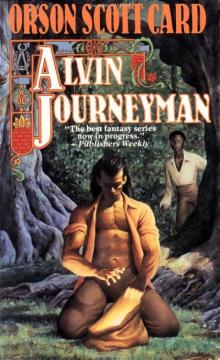 ALVIN JOURNEYMAN
ALVIN JOURNEYMAN The Lost Gate
The Lost Gate Feed The Baby Of Love
Feed The Baby Of Love Hot Sleep: The Worthing Chronicle
Hot Sleep: The Worthing Chronicle